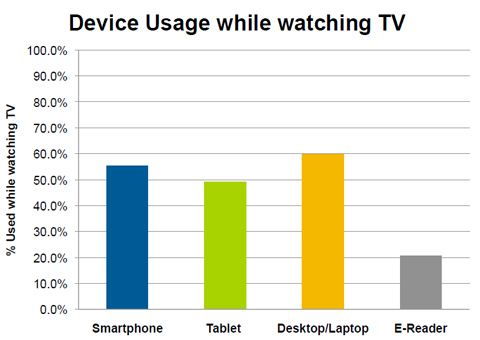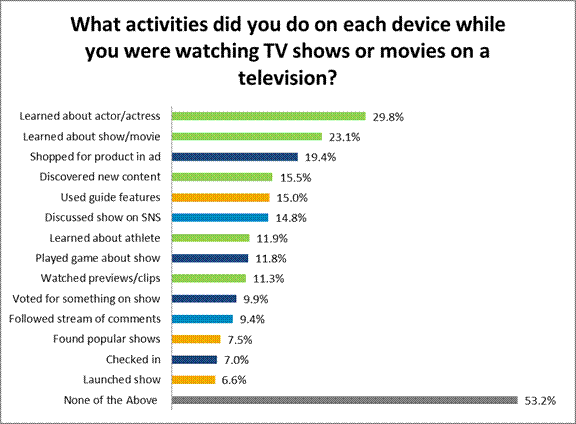Second Screens Vying for TV Viewers' Attention
Tuesday, April 9th, 2013
According to new survey data from The NPD Group, consumers are not widely using applications designed by broadcasters on their laptops, smartphones, and other second-screen devices
PORT WASHINGTON — According to new information from The NPD Group, a global information company, nearly all (88 percent) U.S. households own at least one device that can be used as a second screen, with 87 percent of U.S. entertainment consumers reported to be using at least one second-screen device while watching television. These multitasking consumers are splitting their attention between their televisions and their laptops, tablets, smartphones, and other second-screen devices.
While multitasking is common, viewers are less willing to use their second-screen devices to interact directly with applications designed specifically for the TV programs they are watching. New information from NPD’s “Digital Video Outlook Second Screens Report” report reveals that play-along games, check-in rewards, live voting, and other interactive features are highly effective for the minority of second-screen viewers, but do not resound with most.
When analyzing usage of each individual device over the past three months, PCs were the devices most used simultaneously with TV (60 percent), followed by smartphones (55 percent), and tablets (49 percent).

Among TV viewers who use second-screen devices, only 47 percent have participated in second-screen activities. The most common TV-to-second-screen interaction was learning more about the TV program they were watching, and finding out about the actors in that program. Viggle, zeebox, and other apps designed to enhance second-screen engagement are not commonly used by consumers. Instead, of those TV watchers who engage in second-screen activities, most interact with their TV experience by visiting IMDb, Wikipedia, and social networks.

“Viewers are interested in searching to find further information about TV shows they are watching, but they are not using games and other immersive applications created as a component of the programming,” said Russ Crupnick, senior vice president of industry analysis at NPD. “This situation creates a potential diversion from advertising, and it will take a combined effort from content owners, advertisers, broadcasters, and others to present an aligned second-screen experience that will appeal to viewers.”
Shopping for a product seen in a TV commercial was the third most popular second-screen activity. In particular, laptop users and consumers between the ages of 35 and 49 were most likely to shop for products via their second-screen devices. “Converting viewers into impulse shoppers has big potential impact for advertisers, who can leverage second screens to further connect with consumers watching TV,” Crupnick said.
Data note: Information in this press release was derived from NPD’s “Digital Video Outlook Second Screens Report” report, which is based primarily on information from NPD’s survey of 3,387 NPD consumers who reported watching a TV show or movie in the previous week. Surveys were completed between February 11, 2013 and February 22, 2013.
Latest News
- Barb to start reporting TV-set viewing of YouTube channels
- SAT FILM selects multi-DRM from CryptoGuard
- Qvest and ARABSAT to launch OTT streaming platform
- ArabyAds & LG Ad Solutions partner with TVekstra in Turkey
- Freeview NZ satellite TV service to move to Koreasat 6
- Comscore expands YouTube CTV measurement internationally
